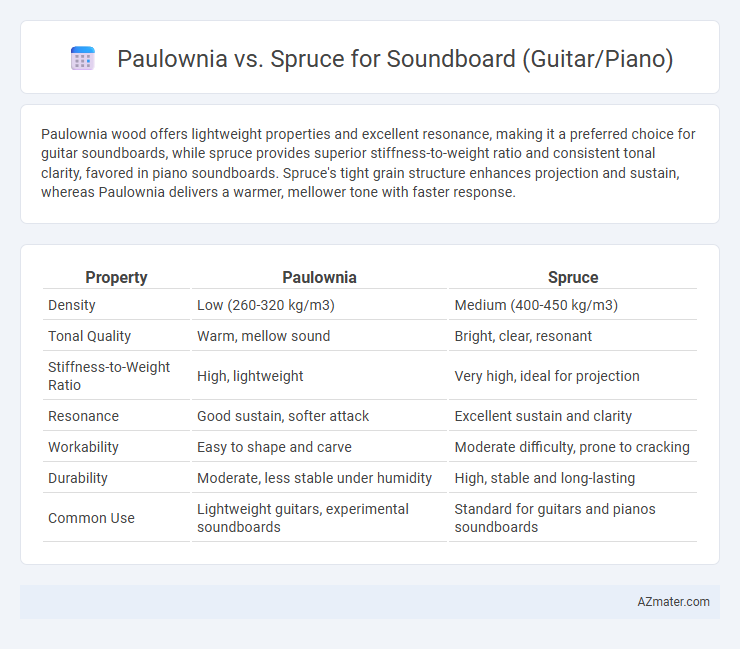Paulownia wood offers lightweight properties and excellent resonance, making it a preferred choice for guitar soundboards, while spruce provides superior stiffness-to-weight ratio and consistent tonal clarity, favored in piano soundboards. Spruce's tight grain structure enhances projection and sustain, whereas Paulownia delivers a warmer, mellower tone with faster response.
Table of Comparison
| Property | Paulownia | Spruce |
|---|---|---|
| Density | Low (260-320 kg/m3) | Medium (400-450 kg/m3) |
| Tonal Quality | Warm, mellow sound | Bright, clear, resonant |
| Stiffness-to-Weight Ratio | High, lightweight | Very high, ideal for projection |
| Resonance | Good sustain, softer attack | Excellent sustain and clarity |
| Workability | Easy to shape and carve | Moderate difficulty, prone to cracking |
| Durability | Moderate, less stable under humidity | High, stable and long-lasting |
| Common Use | Lightweight guitars, experimental soundboards | Standard for guitars and pianos soundboards |
Introduction: The Significance of Soundboard Wood
Paulownia and spruce are two prominent woods used in guitar and piano soundboards, each influencing instrument tone and resonance uniquely. Spruce, especially Sitka and Engelmann varieties, is prized for its strength-to-weight ratio, delivering bright, clear sound with excellent projection. Paulownia, lighter and more porous, offers a warmer, softer tonal character while providing good resonance, making it a popular choice in certain niche acoustic applications.
Paulownia and Spruce: Botanical and Material Profiles
Paulownia (Paulownia tomentosa) features a lightweight, porous structure with a low density around 240-280 kg/m3, promoting excellent resonance and quick sound response, ideal for guitar and piano soundboards. Spruce, typically Sitka (Picea sitchensis) or Engelmann (Picea engelmannii), displays a denser grain structure ranging from 400-450 kg/m3, providing superior stiffness-to-weight ratio and clear tonal projection. Both woods are prized for acoustic properties, but Paulownia offers enhanced sustainability and resistance to environmental changes, while spruce delivers traditional tonal clarity and dynamic range favored in professional instrument manufacturing.
Acoustic Properties: Resonance and Tone
Paulownia offers a lightweight structure with a fast response and bright tonal qualities, making it suitable for instruments requiring clear resonance and crisp articulation. Spruce is renowned for its balanced resonance, strong projection, and warm, rich tone, often preferred in high-end guitars and pianos for its dynamic range and harmonic complexity. The denser grain of Spruce provides superior sustain and tonal depth compared to Paulownia, which delivers a softer, more delicate sound profile.
Weight and Strength Comparison
Paulownia offers a significantly lighter weight compared to spruce, weighing approximately 20-30% less, making it ideal for reducing overall instrument mass while maintaining structural integrity. Despite its lower density, Paulownia exhibits impressive strength-to-weight ratio, providing durability without compromising acoustic responsiveness. Spruce remains the benchmark for soundboards due to its superior stiffness and dynamic range, but Paulownia's combination of lightweight and adequate strength presents an effective alternative for lightweight guitar and piano soundboards.
Response and Projection: Player’s Perspective
Paulownia soundboards offer exceptional responsiveness with a quick attack and enhanced dynamic range, enabling players to articulate subtle nuances effortlessly. Spruce soundboards are renowned for their superior projection, delivering a balanced tone with rich overtones and sustained volume that fill larger spaces effectively. Guitar and piano players often prefer Paulownia for its lively touch and agility, while Spruce remains the benchmark for powerful projection and tonal clarity in professional performance settings.
Workability and Crafting Challenges
Paulownia offers excellent workability due to its lightweight, soft texture, and ease of shaping, making it ideal for intricate soundboard crafting with fewer tools and less effort compared to spruce. Spruce, while harder and denser, requires more precise craftsmanship and tools, but it provides superior stiffness-to-weight ratio, contributing to a more durable soundboard structure. Crafting challenges with paulownia include potential difficulties in achieving consistent tonal quality, whereas spruce demands careful moisture control and finishing techniques to prevent cracking and warping.
Durability and Long-Term Stability
Paulownia offers excellent durability and resistance to environmental changes, making it less prone to warping and cracking over time compared to spruce. Spruce, while renowned for its superior tonal qualities, tends to be more sensitive to humidity and temperature fluctuations, impacting its long-term stability. For soundboards in guitars and pianos, paulownia provides a lightweight yet durable alternative, maintaining structural integrity under varying conditions better than traditional spruce.
Cost, Availability, and Sustainability
Paulownia wood offers a lightweight and resonant soundboard option with lower cost and faster growth rates compared to spruce, making it more sustainable and increasingly available in niche markets. Spruce remains the traditional choice with superior tonal clarity and dynamic range but is costlier and faces supply limitations due to slower growth and overharvesting concerns. Sustainable forestry practices and certifications are critical for both woods, with paulownia's rapid renewability providing a greener alternative for acoustic instruments like guitars and pianos.
Popular Use Cases in Guitars and Pianos
Paulownia wood is favored for guitar soundboards due to its lightweight, strong stiffness-to-weight ratio, and excellent resonance, making it popular in travel and classical guitars for enhanced projection and warmth. Spruce, especially Sitka and Engelmann varieties, dominates piano soundboards and high-end guitars because of its superior stiffness, dynamic range, and clarity, contributing to the instrument's rich tone and sustain. Guitar makers often choose Paulownia for portability and bright tonal qualities, while piano manufacturers rely on spruce for its consistent performance under string tension and broad frequency response.
Final Verdict: Which Wood Suits Your Instrument?
Paulownia offers a lightweight, resonant soundboard ideal for guitars and pianos requiring enhanced sustain and warmth, while spruce provides a balanced tone with superior stiffness and clarity favored by professional musicians for precision. Choose Paulownia for a softer, mellower sound and faster response, particularly in travel guitars or vintage-styled pianos. Opt for spruce when structural stability and bright projection are paramount, often preferred in concert-grade instruments.

Infographic: Paulownia vs Spruce for Soundboard (guitar/piano)
 azmater.com
azmater.com